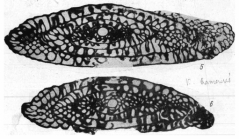Foraminifera taxon details
Kamaina Solovieva in Rauzer-Chernousova et al., 1996 †
1059318 (urn:lsid:marinespecies.org:taxname:1059318)
accepted
Genus
Fusulina kamensis Safonova, 1951 † accepted as Kamaina kamensis (Safonova, 1951) † (type by original designation)
marine, brackish, fresh, terrestrial
fossil only
feminine
Rauzer-Chernousova, D.M., Bensh, F.R., Vdovenko, M.V., Gibshman, N.B., Leven, E.Ya., Lipina, O.A. Reitlinger, E.A., Solovieva, M.N. and Chediya, I.O. (1996). Справочник по систематике фораминифер палеозоя (эндотироиды, фузулиноиды) - Handbook on taxonomy of Paleozoic foraminifera (endotyroids, fusulinoids). <em>Nauka.</em> 1-205., available online at https://books.google.com/books?id=z9FGBQAAQBAJ
page(s): p. 99 [details] Available for editors [request]
[request]
page(s): p. 99 [details] Available for editors
Original description Р. крупная, удлинснно-веретеновидная или субцилиндрическая (L:D до...
Original description Р. крупная, удлинснно-веретеновидная или субцилиндрическая (L:D до 5,5), с округло-приостренными осев, концами, в раннем онтогенезе веретсновидная, быстро удлиняющаяся; поверхность р. неровная, иногда волнистая; нач. к. относительно крупная; число об. 4,5-5,5; шаг спирали высокий; септы с частой высокой неправильной складчатостью, в сечении септальные арки обычно узкие или широкие угловатоокруглые; число септ большое, до 160 в пяти об.; хоматы слабые в 1-2 об. или отсутствуют, псевдохоматы слабые; доп. отл. непостоянные, встречаются слабые осев, уплотнения во внутр. об. или слабое утолщение септ в устьевой обл.; устье очень узкое, иногда неясно выраженное, с непостоянным положением по об. Ок. 10 видов. Ср. карбон, в. московский подъярус, часто подольский гор.; часто В.-Евр. ил. Испания, реже Шпицберген, Ср. Азия, Венгрия.
Test large, elongate-fusiform or subcylindrical (L:D up to 5.5), with roundly pointed axial poles, in early ontogenesis fusiformis-shaped, rapidly elongating; surface of the test irregular, sometimes wavy; proloculus relatively large; number of whorls 4.5-5.5; spiral pitch high; septa with frequent high irregular folding, in cross-section septal arches usually narrow or broadly angular-rounded; number of septa large, up to 160 in fifth whorl; chomata weak in 1-2 whorls or absent, pseudochomata weak; aditional deposits inconstant, weak axial thickening in inner whorls or weak thickening of septa in apertural region; aperture very narrow, sometimes indistinctly expressed, with inconstant position along the whorls. Around 10 species. Middle Carboniferous, upper Moscovian substage, often Podolian horizon; often in eastern Europe or Spain, less frequently Svalbard, Central Asia, Hungary.
(Rauzer-Chernousova et al. (1996)). [details]
Test large, elongate-fusiform or subcylindrical (L:D up to 5.5), with roundly pointed axial poles, in early ontogenesis fusiformis-shaped, rapidly elongating; surface of the test irregular, sometimes wavy; proloculus relatively large; number of whorls 4.5-5.5; spiral pitch high; septa with frequent high irregular folding, in cross-section septal arches usually narrow or broadly angular-rounded; number of septa large, up to 160 in fifth whorl; chomata weak in 1-2 whorls or absent, pseudochomata weak; aditional deposits inconstant, weak axial thickening in inner whorls or weak thickening of septa in apertural region; aperture very narrow, sometimes indistinctly expressed, with inconstant position along the whorls. Around 10 species. Middle Carboniferous, upper Moscovian substage, often Podolian horizon; often in eastern Europe or Spain, less frequently Svalbard, Central Asia, Hungary.
(Rauzer-Chernousova et al. (1996)). [details]
Hayward, B.W.; Le Coze, F.; Vachard, D.; Gross, O. (2025). World Foraminifera Database. Kamaina Solovieva in Rauzer-Chernousova et al., 1996 †. Accessed at: https://marinespecies.org/foraminifera/aphia.php?p=taxdetails&id=1059318 on 2025-09-15
Date
action
by
original description
Rauzer-Chernousova, D.M., Bensh, F.R., Vdovenko, M.V., Gibshman, N.B., Leven, E.Ya., Lipina, O.A. Reitlinger, E.A., Solovieva, M.N. and Chediya, I.O. (1996). Справочник по систематике фораминифер палеозоя (эндотироиды, фузулиноиды) - Handbook on taxonomy of Paleozoic foraminifera (endotyroids, fusulinoids). <em>Nauka.</em> 1-205., available online at https://books.google.com/books?id=z9FGBQAAQBAJ
page(s): p. 99 [details] Available for editors [request]
[request]
page(s): p. 99 [details] Available for editors
From editor or global species database
Original description Р. крупная, удлинснно-веретеновидная или субцилиндрическая (L:D до 5,5), с округло-приостренными осев, концами, в раннем онтогенезе веретсновидная, быстро удлиняющаяся; поверхность р. неровная, иногда волнистая; нач. к. относительно крупная; число об. 4,5-5,5; шаг спирали высокий; септы с частой высокой неправильной складчатостью, в сечении септальные арки обычно узкие или широкие угловатоокруглые; число септ большое, до 160 в пяти об.; хоматы слабые в 1-2 об. или отсутствуют, псевдохоматы слабые; доп. отл. непостоянные, встречаются слабые осев, уплотнения во внутр. об. или слабое утолщение септ в устьевой обл.; устье очень узкое, иногда неясно выраженное, с непостоянным положением по об. Ок. 10 видов. Ср. карбон, в. московский подъярус, часто подольский гор.; часто В.-Евр. ил. Испания, реже Шпицберген, Ср. Азия, Венгрия.Test large, elongate-fusiform or subcylindrical (L:D up to 5.5), with roundly pointed axial poles, in early ontogenesis fusiformis-shaped, rapidly elongating; surface of the test irregular, sometimes wavy; proloculus relatively large; number of whorls 4.5-5.5; spiral pitch high; septa with frequent high irregular folding, in cross-section septal arches usually narrow or broadly angular-rounded; number of septa large, up to 160 in fifth whorl; chomata weak in 1-2 whorls or absent, pseudochomata weak; aditional deposits inconstant, weak axial thickening in inner whorls or weak thickening of septa in apertural region; aperture very narrow, sometimes indistinctly expressed, with inconstant position along the whorls. Around 10 species. Middle Carboniferous, upper Moscovian substage, often Podolian horizon; often in eastern Europe or Spain, less frequently Svalbard, Central Asia, Hungary.
(Rauzer-Chernousova et al. (1996)). [details]
